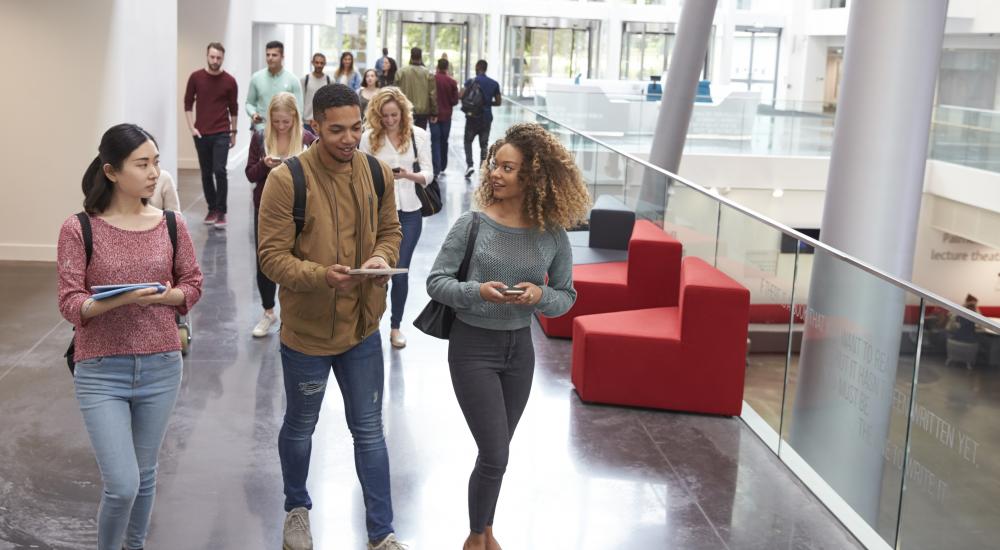Partnering on Campus to Support the Student Journey

At Iowa’s Grinnell College, the offices of international admissions and international student affairs work closely together, and for good reason: international enrollment now makes up 20 percent of the college’s student body. But there’s another reason—their directors, Jonathan and Karen Edwards, are married and have worked together in those roles for a quarter-century.
“It’s about inviting each other into each other’s spaces and priorities,” says Karen Edwards, Grinnell’s associate dean of students and director of international student affairs. “Over the years, we’ve done that in different ways.”
At other institutions, IEM and ISSS leaders likely don’t have quite as close a connection as Jonathan and Karen, but there are still have plenty of reasons to work closely together.
“They must rely on each other to provide services to provide services that recruit, enroll, retain, and graduate students that meet their institutional goals and do the right thing for their students,” says Jackie Girard Vogl, associate vice president for global education at the State University of New York Plattsburgh (SUNY-Plattsburgh).
Two Sides of the Same Coin
When it comes to supporting international students, the two offices represent the entire student experience: the recruitment and application process, followed by ongoing support once students enroll and attend a college or university. And both teams are ultimately focused on the same end goal of ensuring that international students are welcomed, supported, and play a role in attracting future students.
Working closely together can yield concrete results—such as reducing the amount of time between an admissions decision and the generation of an acceptance packet—and more holistic ones, like providing a shared sense of accountability and teamwork.
“They must rely on each other to provide services to provide services that recruit, enroll, retain, and graduate students that meet their institutional goals and do the right thing for their students.” —Jackie Girard Vogl
Depending on the institution, both offices may be in one department or divided among other departments or divisions, such as admissions. While international office staff may not have control over the overall organizational structure, whatever can be done to bring the work closer together is ultimately beneficial, according to Vogl.
“We believe that the structure that works best from the students’ perspective is to have both functions in one place so that it’s easy to find ‘home’ when they arrive on campus,” she says. “Doing so makes the professional lives of our staff richer and the student experience less disjointed.”
Strategies for Partnering
Start with the handoff—or earlier.
The “handoff” during orientation is often the primary focus of collaboration between the two departments. For example, admissions staff with existing relationships with incoming students can help pick them up at the airport and participate in orientation activities.
“This is the perfect time for staff in both offices to show up together in front of all new students,” says Michelle St. Onge, assistant director of SUNY-Plattsburgh’s Global Education Office. “The message could be, ‘We accepted you for admission, now please meet your trusted partners for the next part of the journey.’”
Orientation can serve as a good starting point for IEM and ISSS offices unaccustomed to working closely together. But collaborative work can begin even earlier. At Grinnell, the Jonathan and Karen Edwards jointly develop the pre-arrival communication plan to “share information at the time the student needs it and maybe slightly before,” says Karen Edwards.
“[Orientation] is the perfect time for staff in both offices to show up together in front of all new students.” —Michelle St. Onge
Also consider partnering during recruiting and orientation events. Jonathan Edwards adds that IEM can invite ISSS colleagues to admissions, recruitment, and yield events to present on campus life and orientation topics. Karen Edwards agrees: “I appreciate being included in these activities—this offers students a face, name, and hopefully a glimpse into their future support network,” she says.
ISSS staff can help international admissions colleagues accurately answer a host of questions about student life: if specific majors qualify as STEM, information about internships, whether student housing is available during breaks, and what resources are available to students with different socioeconomic needs. “The more accurately the [admissions staff] know about the student experience, the better they can sell it,” Karen Edwards says.
Address potential immigration roadblocks together.
ISSS staff can be a wealth of information for international admissions professionals, helping them understand immigration policies “so they have some fluency when communicating with prospective students,” says Karen Edwards. At Grinnell, the two offices collaborated on a I-20 request portal and developed video vignettes that walk students through required immigration procedures.
Communicate about individual student needs.
Admissions staff can identify students who may need additional support on campus and communicate that to their peers before students arrive. This helps pinpoint specific services for individual students, such as native language speakers who can serve as mentors, as well as give an ISSS office a bigger-picture perspective on the amount of time needed to support an entire cohort of incoming students, according to St. Onge. “When the admissions team is on the same page as the orientation and ISSS team, we have early warning to put extra supports in place,” she says.
Collaborate on engaging existing students—and future ones.
At Grinnell, Jonathan Edwards asks incoming international students to continue engaging with the admissions office by volunteering to evaluate recommendations, visit their high schools when home for breaks, and apply for guide and overnight host positions, as well as applicant-facing roles within the IEM office itself. ISSS staff also can help identify students to serve as peer recruiters, mentors, or alumni representatives. “Confer with ISSS staff for recommendations on the best students to hire for admission work and connecting with prospective students,” he says.
Find opportunities to learn each other’s roles.
At smaller institutions, each office may only have one or two staff members, helping simplify collaboration. Larger offices may need more intentional efforts, including retreats, weekly emails, and informal opportunities to communicate like coffee breaks or meals, according to St. Onge. “Current international students bond around food and cultural exchanges, and these are excellent opportunities to connect the staff in both offices around shared experiences,” she says.
Another strategy involves staff pitching in during peak periods for each other’s offices—for example, having admissions staff help generate the initial I-20 forms at the start and end of semesters, or having ISSS staff communicate with accepted applicants during the decision-making period, according to St. Onge. Doing so helps enhance understanding of the full student lifecycle and “leads to mutual respect for each other’s roles and responsibilities,” Vogl adds.
Learn from other programs with similar challenges.
International offices aren’t the only programs on campus with unique student recruiting and support responsibilities. Consider learning from programs such as athletics and the U.S. Department of Education’s TRIO Student Support Services, which have their own connected admissions and support processes, according to St. Onge.
Don’t forget the rest of campus.
International students aren’t admitted, or exist on campus, in a vacuum. It’s important to work closely with faculty, career advisers, campus safety, residence life, student health, and other members of the college community who regularly interact with international students. That represents a growing shift.
“When we started in this work years ago, we were thinking about how we help individual students navigate through the journey,” Karen Edwards says. “Now increasingly, our work involves helping other offices and partners on campus.”
Cross-campus collaboration is particularly important at institutions where international students represent a significant part of the overall student population. In those cases, messaging involving a wide range of services—from billing and student health services to internships and career services—needs to reflect the entire student body.
“If you’re sending out bills and 20 percent of students are paying from overseas, the messaging needs to be inclusive to all to avoid having to send separate messages and serve our students well,” Karen Edwards says.
Over time, partnering with other departments can result in a much richer network of support that transcends both IEM and ISSS offices. “In addition to inviting international students to campus, we need to be prepared to serve them well,” says Karen Edwards. “That requires a campuswide commitment to our global student body.” •
NAFSA Resources
- Collegial Conversation: “Building Bridges: How IEM and ISSS Collaborate for Success”
- Collegial Conversation: “Successful International Student Peer Mentoring: Demonstrating #YouAreWelcomeHere in Onboarding and Orientation Programming”
- Peer-to-Peer Perspectives: “Examples from the Field: Using Social Media to Build Community and Connect with Incoming Students”
About International Educator
International Educator is NAFSA’s flagship publication and has been published continually since 1990. As a record of the association and the field of international education, IE includes articles on a variety of topics, trends, and issues facing NAFSA members and their work.
From in-depth features to interviews with thought leaders and columns tailored to NAFSA’s knowledge communities, IE provides must-read context and analysis to those working around the globe to advance international education and exchange.
About NAFSA
NAFSA: Association of International Educators is the world's largest nonprofit association dedicated to international education and exchange. NAFSA serves the needs of more than 10,000 members and international educators worldwide at more than 3,500 institutions, in over 150 countries.
NAFSA membership provides you with unmatched access to best-in-class programs, critical updates, and resources to professionalize your practice. Members gain unrivaled opportunities to partner with experienced international education leaders.














